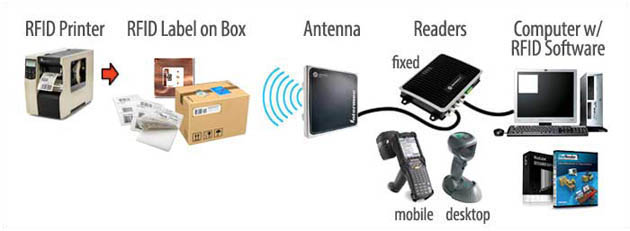Product Category

TEL: +86-13927455531
Email: sales@passive-rfid-tags.com
Passive, Active, and BAP RFID Systems

Passive, Active, and BAP RFID Systems
Active RFID Systems
In active RFID systems, tags have their own transmitter and power source. Usually, the power source is a battery. Active tags broadcast their own signal to transmit the information stored on their microchips.
Active RFID systems typically operate in the ultra-high frequency (UHF) band and offer a range of up to 100 m. In general, active tags are used on large objects, such as rail cars, big reusable containers, and other assets that need to be tracked over long distances.
There are two main types of active tags: transponders and beacons. Transponders are “woken up” when they receive a radio signal from a reader, and then power on and respond by transmitting a signal back. Because transponders do not actively radiate radio waves until they receive a reader signal, they conserve battery life.
Beacons are used in most real-time locating systems (RTLS), in order to track the precise location of an asset continuously. Unlike transponders, beacons are not powered on by the reader’s signal. Instead, they emit signals at pre-set intervals. Depending on the level of locating accuracy required, beacons can be set to emit signals every few seconds, or once a day. Each beacon’s signal is received by reader antennas that are positioned around the perimeter of the area being monitored, and communicates the tag’s ID information and position.
Passive RFID Systems
In passive RFID systems, the reader and reader antenna send a radio signal to the tag. The RFID tag then uses the transmitted signal to power on, and reflect energy back to the reader.
Passive RFID systems can operate in the low frequency (LF), high frequency (HF) or ultra-high frequency (UHF) radio bands. As passive system ranges are limited by the power of the tag’s backscatter (the radio signal reflected from the tag back to the reader), they are typically less than 10 m. Because passive tags do not require a power source or transmitter, and only require a tag chip and antenna, they are cheaper, smaller, and easier to manufacture than active tags.
Passive tags can be packaged in many different ways, depending on the specific RFID application requirements. For instance, they may be mounted on a substrate, or sandwiched between an adhesive layer and a paper label to create smart RFID labels. Passive tags may also be embedded in a variety of devices or packages to make the tag resistant to extreme temperatures or harsh chemicals.
Passive RFID solutions are useful for many applications, and are commonly deployed to track goods in the supply chain, to inventory assets in the retail industry, to authenticate products such as pharmaceuticals, and to embed RFID capability in a variety of devices. Passive RFID can even be used in warehouses and distribution centers, in spite of its shorter range, by setting up readers at choke points to monitor asset movement.
Battery-Assisted Passive (BAP) Systems
A Battery-Assisted Passive RFID tag is a type of passive tag which incorporates a crucial active tag feature. While most passive RFID tags use the energy from the RFID reader’s signal to power on the tag’s chip and backscatter to the reader, BAP tags use an integrated power source (usually a battery) to power on the chip, so all of the captured energy from the reader can be used for backscatter. Unlike transponders, BAP tags do not have their own transmitters.
| Active RFID | Passive RFID | Battery-Assisted Passive (BAP) | |
|---|---|---|---|
| Tag Power Source | Internal to tag | Energy transfer from the reader via RF | Tag uses internal power source to power on, and energy transferred from the reader via RF to backscatter |
| Tag Battery | Yes | No | Yes |
| Availability of Tag Power | Continuous | Only within field of reader | Only within field of reader |
| Required Signal Strength from Reader to Tag | Very Low | Very high (must power the tag) | Moderate (does not need to power tag, but must power backscatter) |
| Available Signal Strength from Tag to Reader | High | Very Low | Moderate |
| Communication Range | Long Range (100m or more) | Short range (up to 10m) | Moderate range (up to 100m) |
| Sensor Capability | Ability to continuously monitor and record sensor input | Ability to read and transfer sensor values only when tag is powered by reader | Ability to read and transfer sensor values only when tag receives RF signal from reader |